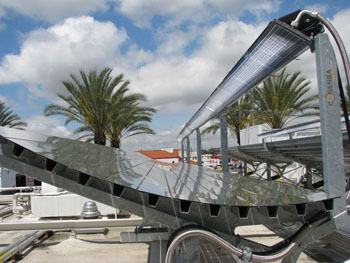Cogenra Solar's Next Big Move: Solar Cooling
 Cogenra Solar, the California startup that uses mirrors and solar cells to generate electricity and hot water, has expanded internationally, broken into a broad range of industries and landed a number of big name commercial customers in the past year, including Facebook, Kendall-Jackson Winery and the U.S. Department of Defense. The company has now added solar cooling to the mix, a product tweak well-suited for the data center, hotel and food and beverage industries.
Cogenra Solar, the California startup that uses mirrors and solar cells to generate electricity and hot water, has expanded internationally, broken into a broad range of industries and landed a number of big name commercial customers in the past year, including Facebook, Kendall-Jackson Winery and the U.S. Department of Defense. The company has now added solar cooling to the mix, a product tweak well-suited for the data center, hotel and food and beverage industries.Cogenra has launched a pilot project at Southern California Gas Company’s Energy Resource Center that will capture and store heat from its solar cogeneration system and use it to power an absorption chiller and support the building’s air conditioning.
Cogenra isn’t reinventing the wheel. Absorption chillers, which typically use a heat source to provide cooling, have been around a long time in the industrial world. And solar cooling isn’t a completely new concept either. However, the combination of electricity-hot-water-cooling is an innovation that could give Cogenra access to a much larger market.
How the technology works
Traditional solar photovoltaic arrays convert about 15 percent of the sun’s energy into electricity. The rest of the energy is wasted, mostly in the form of heat. Cogenra’s system captures the waste heat and uses it to heat water and cool the PV components.
The next step is to add the solar cooling component. Absorption chillers need heat, said Mani Thothadri, Cogenra’s senior director of marketing and product. The hot water contained in storage tanks can be routed to the absorption chiller.
“Since our installation already has a storage facility, we can convert the heat in the storage tanks directly into cooling on demand,” Thothadri told me in a recent interview. “That’s a big deal because typically customers not only pay energy charges, they pay demand charges as well.”
The storage component also helps smooth out the intermittent energy produced by the solar panels. For example, it can still provide hot water and power the chiller even on cloudy days or at night.
The solar cooling component can be retrofitted onto existing Cogenra installations. However, solar cooling requires more energy and more modules would have to be added to meet demand, Thothadri said.
According to Thothadri, the hybrid system (with the solar cooling component) has a payback period of about five years. That relatively short timeframe is achieved because the system not only displaces natural gas use (for the hot water), but electricity from the grid as well.
Thothadri wouldn’t provide any details on Cogenra’s next solar cooling customers. He did say Cogenra is in discussions with existing and potential customers, including data centers about installing its solar cogeneration and cooling system.
You can return to the main Market News page, or press the Back button on your browser.

